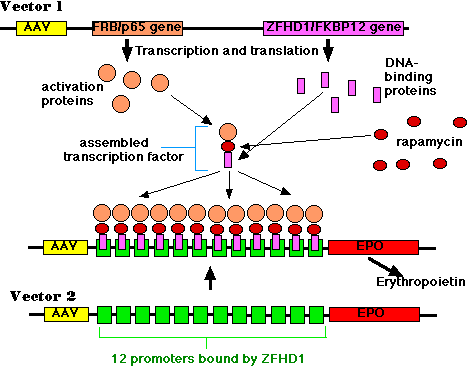Gene Therapy Update
Problems
Reaching the goal of effective gene therapies for human diseases has been a difficult one.
Some of the problems that remain to be solved include:
- how to avoid an immune response in the patient, which can interfere with gene therapy in two ways:
- the vector provokes inflammation (a problem with adenovirus vectors)
- the vector elicits antibodies that destroy the vector when it is administered again
- how to get the gene into non-dividing cells like liver, muscle, and neurons
- how to get the gene integrated into the DNA of the host cell so that it will be replicated (in dividing cells) and expressed indefinitely
- how to get the gene to be expressed as needed; that is, how to bring the gene under normal physiological controls so that its product is produced when and in the amounts needed.
Adeno-associated virus (AAV) - A possible solution?
Adeno-associated virus gets its name because it is often found in cells that are simultaneously infected with adenovirus. However, by itself it seems to be harmless.
Unlike adenovirus, AAV
- does not stimulate inflammation in the host
- does not elicit antibodies against itself
- can enter non-dividing cells
- integrates successfully into one spot in the genome of its host (on chromosome 19 in humans).
As for the last criterion - how to get the transgene to be expressed appropriately - that may be solved by using two AAV vectors simultaneously:
The strategy in action.
In the 1 January 1999 issue of Science, James M. Wilson and his colleagues reported the results of using this strategy in both mice and rhesus monkeys.
They injected their experimental animals with two vectors.
 This piece of DNA contained (among other things):
This piece of DNA contained (among other things):
- the DNA of adeno-associated virus (AAV)
- a gene encoding a protein containing two domains:
- a portion of the molecule ("p65") that is needed to activate gene transcription but that by itself cannot bind to DNA
- a portion ("FRB") that binds the drug rapamycin.
- a gene encoding another protein with two domains:
- a portion of molecule ("ZFHD1") that binds specifically to the DNA sequence in the promoter of the erythropoietin gene but that by itself cannot activate transcription of the gene;
- a portion ("FKBP12") that also binds to rapamycin.
- promoters (not shown) that allow continuous expression (transcription and translation) of the two genes. But note that, by themselves, the two gene products are inactive.
Vector 2
This piece of DNA contained (among other things):
- the DNA of adeno-associated virus (AAV);
- 12 identical promoters (green boxes) of the erythropoietin gene;
- the structural gene for erythropoietin (EPO) itself.
The Experiment
The experimental animals were injected (in their skeletal muscles) with many copies of both vectors. Skeletal muscle was chosen because muscle fibers are multinucleate. Once across the plasma membrane, there are many nuclei which the vectors can enter and hence many opportunities to integrate into the DNA of the host.
Later the animals were injected with rapamycin. This small molecule is an immunosuppressant and is currently being tested in transplant recipients to help them avoid rejection of the transplant. It was used here because of its ability to simultaneously bind to the FRB and FKBP12 domains of the two gene products of vector 1. The resulting trimer is an active transcription factor for the erythropoietin gene.
The Results
In mice
- injections of the two vectors had - by themselves - no effect on the production of EPO nor on the number of red blood cells (hematocrit), but
- every time these animals were given an injection of rapamycin, they
- quickly began to produce EPO (with levels increasing as much as 100 fold) and
- the number of red blood cells rose (hematocrits increasing from 42% to 60%).
- The amount of EPO produced was directly related to the amount of rapamycin given.
- Even after 5 months, a single injection of rapamycin produced a sharp rise in the level of EPO in the blood.
In monkeys
The results were similar to those in mice, but the effect wore off after 4 months.
So here is a system where a gene introduced into an animal can then be
- switched on by giving the animal a small molecule. (In humans, rapamycin can be given by mouth as a pill.)
- can have its output regulated by the amount of the small molecule administered.
The Outlook
Further trials (Phase I trials are already planned) may eventually lead to effective, controlled, gene therapy for such single-gene disorders as
20 September 1999
 This piece of DNA contained (among other things):
This piece of DNA contained (among other things):